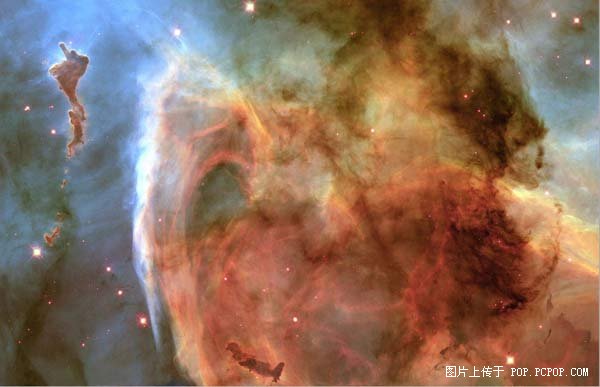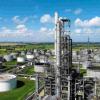Dear all
I need yoru valuable technical advice here. This is first time I seen inquiry to design Kettle Reboiler heat exchanger whereby the shell side (cold stream) inlet and outlet temp is the same (undergoes Isentropic and phase change only), 177C, inlet as liquid stream and outlet became 2 phase, liquid % : 98% and vapor %: 8.2%
The KB (BKU type, TEMA R) thermal duty is 15,510 kW. Both shell and tube side is tow phase. Tube side is 2 phase Low Pressure steam. Shell side is isentropic, not temp change liquid inlet and outlet slighly vapor content.
See process datasheet below:
Shell Side Tube Side
Flow rate, kg/hr 309,434 26,029
Liquid %, in/out 100 91.8 0 100
Vapor %, in/out 0 8.2 100 0
Temp C, in/out 117 117 160 147
Presure drop, Bar 0.2353 0
Fouling resistance 0.00017 0.00017
Tube Side Hot (LP Steam)
Phase: 2 - Phase
Data Source: Single component from NEL40
Code: Water/Steam
Shell Side Cold
Liquid Temp, C 117
Liquid Density, kg/m3 973
Liquid specific heat, Kj/kg.K 4.092
Liquid viscosity, cP 0.69
Liquid Thermal Conductivity, W/mK 0.55
Temp for Enthapies, C 117 117
Specific Enthapies, Kj/kg 0 468 (equivalent to 15510 kW of Hx Thermal duty?)
Vapor fraction 0 0.082
Vap Temp, C 117
Vap Density, Kg/m3 0.92
Vap Spec Heat, Kj/KgK 2.101
Vap. Viscosity, cP 0.012
Vap. Thermal Conductivity, W/mK 0.024
I never run TASC for isentropic case (not temp change in shell side). The program keep telling me the 15510 kw duty is under estimate neither base on shell side m.Cp.T or Tube side M.Cp.T, different by 50% or more.
Anyone experience here can share your advice?
Regards
DTan76
|
|

Kettle Reboiler Heat Exchanger
Started by Dtan76, Aug 03 2006 02:14 AM
3 replies to this topic
Share this topic:
#1

Posted 03 August 2006 - 02:14 AM
#2

Posted 03 August 2006 - 09:20 PM
hi,
I hope you know that the main purpose of kettle type reboilers is to produce vapors from liquid at the same temperature. In other words, ONLY LATENT HEAT TRANSFER.
The vapors produce will be in equilibrium with liquid in both thermal and mass transfer. The composition of both phases may be different based on fluid handled.
You have said that the "outlet became 2 phase, liquid % : 98% and vapor %: 8.2%" which seems to be incorrect because it is > 100%. Please check and confirm your query.
As per standards, for kettle type reboilers, the outlet of cold side, vapor % should be around 30% (70%=liquid) for better process control. You can provide this parameter in your design calculations. Remember that your heat duty is only for those 30% vapors. No part of heat duty is utilized for liquid because it is at same temperature. Your % vaporization will also depend on the "static height" available for your reboiler. So, it is "give and take" between these two parameters (static height & %vaporization). During construction of reboiler, the static height arrived during design must be met; otherwise reboiler operation may not work properly.
You also need to be careful about total pressure drop in the circuit which comprises of following.
[1] Line pressure drop at inlet [2] reboiler pressure drop [3] Line pressure drop at outlet.
It is the ONLY STATIC HEAD OR HEIGHT which will help to overcome the pressure drop of total circuit.
NOW COMING TO YOUR PROBLEM,
Your heat duty is governed by process side. the amount of total vapor (kg/hr) required to be generated for process. You can calculated based on Q = m x (latent heat).
Now, when you provide data for TUBE SIDE, you should NOT provide flow rate of steam. Because, it will be calculated based on heat duty as defined above and the conditions of steam (temp & press). However, you can provide estimated flow rate based on your hand calculations.
So, try to provide only conditions of steam on tube side. 'delete' the flow rate.
You say that "Tube side is 2 phase Low Pressure steam". This is not correct as per your process data sheet. Your tube side inlet is 100% vapor at 160 deg C.
Outlet of tube side is at 147 deg C which is condensate. What is the pressure of LP steam at inlet of exchanger? Since you have said it is LP steam, i assume it would be 'superheated' at 160 deg C.
Try to use "saturated" LP steam, if possible. This would give you better design of reboiler.
Any more opinions?
I hope you know that the main purpose of kettle type reboilers is to produce vapors from liquid at the same temperature. In other words, ONLY LATENT HEAT TRANSFER.
The vapors produce will be in equilibrium with liquid in both thermal and mass transfer. The composition of both phases may be different based on fluid handled.
You have said that the "outlet became 2 phase, liquid % : 98% and vapor %: 8.2%" which seems to be incorrect because it is > 100%. Please check and confirm your query.
As per standards, for kettle type reboilers, the outlet of cold side, vapor % should be around 30% (70%=liquid) for better process control. You can provide this parameter in your design calculations. Remember that your heat duty is only for those 30% vapors. No part of heat duty is utilized for liquid because it is at same temperature. Your % vaporization will also depend on the "static height" available for your reboiler. So, it is "give and take" between these two parameters (static height & %vaporization). During construction of reboiler, the static height arrived during design must be met; otherwise reboiler operation may not work properly.
You also need to be careful about total pressure drop in the circuit which comprises of following.
[1] Line pressure drop at inlet [2] reboiler pressure drop [3] Line pressure drop at outlet.
It is the ONLY STATIC HEAD OR HEIGHT which will help to overcome the pressure drop of total circuit.
NOW COMING TO YOUR PROBLEM,
Your heat duty is governed by process side. the amount of total vapor (kg/hr) required to be generated for process. You can calculated based on Q = m x (latent heat).
Now, when you provide data for TUBE SIDE, you should NOT provide flow rate of steam. Because, it will be calculated based on heat duty as defined above and the conditions of steam (temp & press). However, you can provide estimated flow rate based on your hand calculations.
So, try to provide only conditions of steam on tube side. 'delete' the flow rate.
You say that "Tube side is 2 phase Low Pressure steam". This is not correct as per your process data sheet. Your tube side inlet is 100% vapor at 160 deg C.
Outlet of tube side is at 147 deg C which is condensate. What is the pressure of LP steam at inlet of exchanger? Since you have said it is LP steam, i assume it would be 'superheated' at 160 deg C.
Try to use "saturated" LP steam, if possible. This would give you better design of reboiler.
Any more opinions?
#3

Posted 04 August 2006 - 02:07 AM
Dear Sir
Thanks for your valuable advice, it is very helpful to me.
Refer to my previous posted thread, sorry allow me to make correction here the shell side stream (cold side) stream in/out should be liquid: 100%/91.8% and vapor in/out: 0%/8.2% instead.
The latent heat estimated for this medium - MDEA (shell side) is 2,200 KJ/mol, and the total heat exchanger duty to evaporate this amount of liquid into 8.2% vapor is 15510 kw.
The latent heat formula is calculated using therm. equation which is:
Hn/Tn = R * (1.092(InPc - 1.013)/(0.93 - Trn))
Where Tn = Liquid boilling point = 520K
Pc = Critical pressure, Bar = 3700/101 = 35.64 Bar
Trn = Reducer Temp = 520/677 = 0.789
R = 8.314J/Mol.K
Substitue all variables above, I obtained the latent heat for MDEA.
Amount of energy required = Total Shell Flow rate x 0.082 x latent heat
= 5.584 E07 KJ/hr = 15510 kw
As per your recommendation, I DELETE the TUBE SIDE LP steam flow rate but I fixed the in/outlet temp as 160C/147C. TASC will calculate arbitrary the LP flow rate by adjusting to the 15510 kw heat load input in shell side.
The pressure inlet of shell/tube side is 0.7845 Barg/shell and 3.4323 Barg/tube.
In the TASC program, for Tube Side - LP Stream previously I has choose setup as "Tow Phase" as the inlet is super heated steam and outlet is condenser steam.
Everything done, i run the simulation and I get pretty nice result as follow:
Shell diam/length/total area : 1200 mm/6000 mm/ 377m2
No of passes/no of tubes: 2/988
Total mass shell/tube: 309434 kg/hr / 25900 kg/hr (LP steam, very close to estimated)
Total pressure drop shell/tube: 0.3536 Bar / 2.3287 Bar (Tube side very high pressure drop, how??)
Overall heat transfer coeef clean/dirty: 381.9 W/m2.k / 1447 W/m2.K
Heat load: 15510 kW
Area ratio: 1.032
I got pretty good Area ratio, slightly > 1.0
But how to optimize and reduce tuve side pressure drop, <0.7Bar
Many thanks and regards
Thanks for your valuable advice, it is very helpful to me.
Refer to my previous posted thread, sorry allow me to make correction here the shell side stream (cold side) stream in/out should be liquid: 100%/91.8% and vapor in/out: 0%/8.2% instead.
The latent heat estimated for this medium - MDEA (shell side) is 2,200 KJ/mol, and the total heat exchanger duty to evaporate this amount of liquid into 8.2% vapor is 15510 kw.
The latent heat formula is calculated using therm. equation which is:
Hn/Tn = R * (1.092(InPc - 1.013)/(0.93 - Trn))
Where Tn = Liquid boilling point = 520K
Pc = Critical pressure, Bar = 3700/101 = 35.64 Bar
Trn = Reducer Temp = 520/677 = 0.789
R = 8.314J/Mol.K
Substitue all variables above, I obtained the latent heat for MDEA.
Amount of energy required = Total Shell Flow rate x 0.082 x latent heat
= 5.584 E07 KJ/hr = 15510 kw
As per your recommendation, I DELETE the TUBE SIDE LP steam flow rate but I fixed the in/outlet temp as 160C/147C. TASC will calculate arbitrary the LP flow rate by adjusting to the 15510 kw heat load input in shell side.
The pressure inlet of shell/tube side is 0.7845 Barg/shell and 3.4323 Barg/tube.
In the TASC program, for Tube Side - LP Stream previously I has choose setup as "Tow Phase" as the inlet is super heated steam and outlet is condenser steam.
Everything done, i run the simulation and I get pretty nice result as follow:
Shell diam/length/total area : 1200 mm/6000 mm/ 377m2
No of passes/no of tubes: 2/988
Total mass shell/tube: 309434 kg/hr / 25900 kg/hr (LP steam, very close to estimated)
Total pressure drop shell/tube: 0.3536 Bar / 2.3287 Bar (Tube side very high pressure drop, how??)
Overall heat transfer coeef clean/dirty: 381.9 W/m2.k / 1447 W/m2.K
Heat load: 15510 kW
Area ratio: 1.032
I got pretty good Area ratio, slightly > 1.0
But how to optimize and reduce tuve side pressure drop, <0.7Bar
Many thanks and regards
#4

Posted 08 August 2006 - 08:19 PM
Dtan,
The tube side dP mainly depends on
[1] Tube diameter
[2] No. of tube passes
[3] No. of tubes.
Now, what tube diameter did you use? If you used 3/4" (19.05 mm OD; most common), you can try for 1"(25.4 mmOD).
To optimize the heat exchanger design incluldes many more factors. Because they all are inter related. When I say to increase the tube dia., it will reduce the velocity & turbulence. This may give you lower heat transfer co-efficient and in turn it may decrease desing margins or may lead to possible under design.
However, you can improve heat transfer co-efficient by changing varoius parameters on shell side too.
So, it is better to seek advice from someone around you in your organization who has experience of heat exch design and who can be with you while you are optimizing. There are many combinations of parameters which you can utilize to optimize your design while meeting all design limitations and process requirements.
regards,
The tube side dP mainly depends on
[1] Tube diameter
[2] No. of tube passes
[3] No. of tubes.
Now, what tube diameter did you use? If you used 3/4" (19.05 mm OD; most common), you can try for 1"(25.4 mmOD).
To optimize the heat exchanger design incluldes many more factors. Because they all are inter related. When I say to increase the tube dia., it will reduce the velocity & turbulence. This may give you lower heat transfer co-efficient and in turn it may decrease desing margins or may lead to possible under design.
However, you can improve heat transfer co-efficient by changing varoius parameters on shell side too.
So, it is better to seek advice from someone around you in your organization who has experience of heat exch design and who can be with you while you are optimizing. There are many combinations of parameters which you can utilize to optimize your design while meeting all design limitations and process requirements.
regards,
Similar Topics
Heat Loss Calculation From Cylindrical Tan;Started by Guest_rasprocess2026_* , 23 Jul 2025 |
|

|
||
Distillation Column Reboiler QuestionsStarted by Guest_AlanC079_* , 07 Jul 2025 |
|

|
||
Levels For Kettle Type ReboilerStarted by Guest_RajD_* , 04 Apr 2025 |
|

|
||
Steam Pressure In Heat ExchangerStarted by Guest_mvanrijnbach_* , 15 Apr 2025 |
|

|
||
Heat Exchanger Steam FlowStarted by Guest_aliebrahem17_* , 25 Nov 2024 |
|

|

 FB
FB







